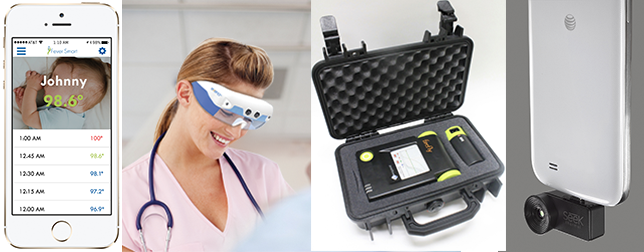New Ebola research by the Arizona State University demonstrates that quick and forceful implementation of control interventions are necessary to control outbreaks and avoid far worse scenarios. And this is not only true for the Ebola epidemic but also for other plagues of our times. At WT we took a closer look at wearable devices that might have the potential to support caregivers and patients in the fight against Ebola.
Protective Gear and Hygiene Compliance are Key
There is a lot of protective gear required in Ebola patients’ care. To additionally improve hygiene compliance the company intelligentM has developed a smart band to help monitor, manage, and improve healthcare workers’ hand hygiene. This is not the only approach to improving this factor in patient care: Several patents have been filed that focus solely on improving hygiene compliance.
Making the Invisible Visible
Temperature sensing has been in the news for identifying potential Ebola cases. There are quite a few interesting devices enabling augmented reality applications that could be used to detect body temperature. There is for example the FLIR ONE™ a thermal camera integrated in a smartphone cover that snaps on your phone. The camera can make things visible that cannot be perceived by the naked eye. With thermal imaging the device expands the portion of the spectrum we perceive dramatically helping us “see” heat for example in the accompanying smartphone app. A similar thermal imaging smartphone accessory called IR-Blue is available from a company called RH Workshop. And there is a third thermal camera for your smartphone from the company Seek Thermal. The tiny camera plugs into your iOS or Android phone and also makes thermal sensing possible via an app.
Continuous Temperature Monitoring Facilitated through Wearables
While it is still in discussion if the thermal scanners currently used at some airports are truly effective prevention tools or merely a placebo, it is clear that monitoring an infected person’s temperature is important. Wearable devices that can continuously monitor the temperature can also limit the times of skin contact for a care giver. One such device is for example marketed by Vicks. The disposable underarm thermometer continuously monitors temperature for up to 48 hours offering professional accuracy. There is also a smart patch thermometer for kids – the Fever Smart – that was recently seeking funding on indiegogo. The device sits comfortably under a child’s armpit and allows continuous readings. A smart armband type thermometer for kids called iTherm is also continuously measuring temperature in combination with a smartphone. Both devices allow you to program alarms to alert you when the temperature reaches a certain threshold. While they are only targeted at kids at the moment we don’t see a problem why these two latter devices could not also be made available for grown-ups. Last but not least we discovered another bracelet type thermometer coming from the Taiwanese company Shield. The battery of their so called Shieldband lasts one entire year which is an important factor in the continuous reading of temperature.
Virus Detection on the Spot
Diagnostics of Ebola is also tricky and not always fast enough and temperature not a save indicator. The biological detection and diagnostics company PositiveID offers a new handheld device that could be used to detect Ebola in minutes at the point of need. The device is part of the company’s system called Firefly Dx and funded by the American Department of Homeland Security.
Quick Identification of Source of Infection
Another approach is suggested by the company Awarepoint. They suggest embracing their real time location software (RTLS) technology in hospitals to detect potential exposure of staff and other patients to the Ebola virus. The system equips staff and patients with wearable tags to record the location and proximity of all staff and patients throughout the facility, at all times. If a patient infection is later confirmed, all staff and patients that were located in the proximity of that patient may be identified within in a few seconds.
There are also a few new interesting approaches for detecting diseases from breath or sweat; however, these are not targeted at the Ebola virus yet and are also still rather far away from becoming reality anytime soon.
Visit WT at MEDICA
To see more wearable medical innovations visit our WT I Wearable Technologies Show 2014 at Medica next week in hall 15, Booth A23. The show will be running from November 12-15, 2014 and will be held in Düsseldorf (Germany). For example our exhibitor Evena Medical will show their unique smart glasses that facilitates the difficult skill of venipuncture (stick patients with needles). This most common invasive medical procedure becomes even more difficult in challenging situations and extremely difficult with patients with possible Ebola or other infectious diseases. Currently Infusion Nurses Society (INS) reports that first stick attempts fail 40% of the time. Evena Medical’s glasses can reduce the number of attempts considerably making “invisible” veins visible to medical staff, speeding up the process.












